Case Study Assessment: Pathophysiology, Nursing Priority, and ABG Assessment
VerifiedAdded on 2023/04/07
|6
|1461
|51
AI Summary
This case study assesses the pathophysiology of a patient with urinary tract infection and sepsis, nursing priorities, and ABG assessment. It discusses the spread of urinary tract infection, the role of bacteria, and the impact on the patient's vital signs. The nursing strategy focuses on managing acute respiratory distress syndrome, while the ABG assessment evaluates the patient's pH, PaO2, HCO3, BE, and lactate levels. Urgent attention is required for the deteriorating patient state.
Contribute Materials
Your contribution can guide someone’s learning journey. Share your
documents today.

Case study assessment
University
Unit
Name
Tutor
Date
University
Unit
Name
Tutor
Date
Secure Best Marks with AI Grader
Need help grading? Try our AI Grader for instant feedback on your assignments.
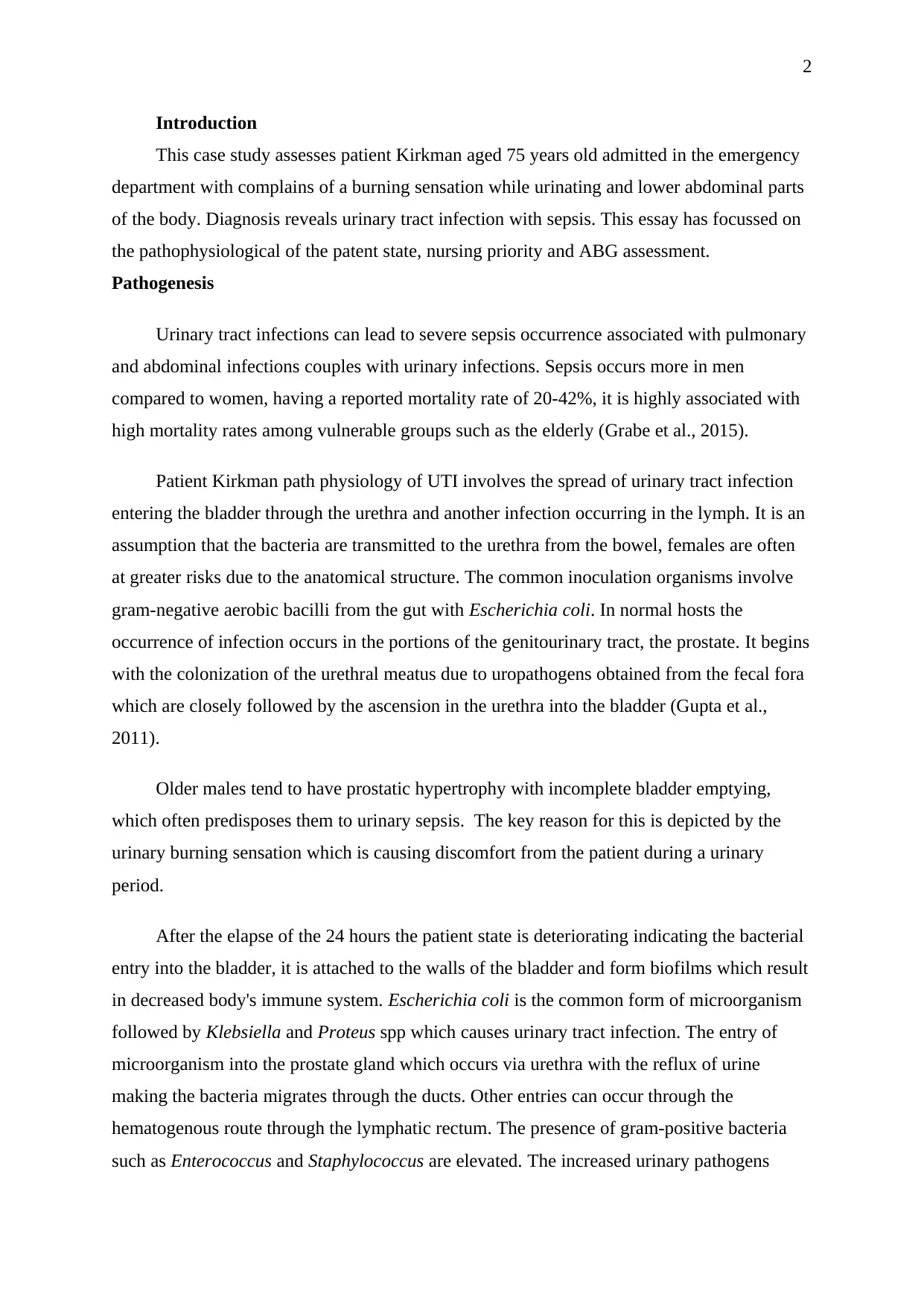
2
Introduction
This case study assesses patient Kirkman aged 75 years old admitted in the emergency
department with complains of a burning sensation while urinating and lower abdominal parts
of the body. Diagnosis reveals urinary tract infection with sepsis. This essay has focussed on
the pathophysiological of the patent state, nursing priority and ABG assessment.
Pathogenesis
Urinary tract infections can lead to severe sepsis occurrence associated with pulmonary
and abdominal infections couples with urinary infections. Sepsis occurs more in men
compared to women, having a reported mortality rate of 20-42%, it is highly associated with
high mortality rates among vulnerable groups such as the elderly (Grabe et al., 2015).
Patient Kirkman path physiology of UTI involves the spread of urinary tract infection
entering the bladder through the urethra and another infection occurring in the lymph. It is an
assumption that the bacteria are transmitted to the urethra from the bowel, females are often
at greater risks due to the anatomical structure. The common inoculation organisms involve
gram-negative aerobic bacilli from the gut with Escherichia coli. In normal hosts the
occurrence of infection occurs in the portions of the genitourinary tract, the prostate. It begins
with the colonization of the urethral meatus due to uropathogens obtained from the fecal fora
which are closely followed by the ascension in the urethra into the bladder (Gupta et al.,
2011).
Older males tend to have prostatic hypertrophy with incomplete bladder emptying,
which often predisposes them to urinary sepsis. The key reason for this is depicted by the
urinary burning sensation which is causing discomfort from the patient during a urinary
period.
After the elapse of the 24 hours the patient state is deteriorating indicating the bacterial
entry into the bladder, it is attached to the walls of the bladder and form biofilms which result
in decreased body's immune system. Escherichia coli is the common form of microorganism
followed by Klebsiella and Proteus spp which causes urinary tract infection. The entry of
microorganism into the prostate gland which occurs via urethra with the reflux of urine
making the bacteria migrates through the ducts. Other entries can occur through the
hematogenous route through the lymphatic rectum. The presence of gram-positive bacteria
such as Enterococcus and Staphylococcus are elevated. The increased urinary pathogens
Introduction
This case study assesses patient Kirkman aged 75 years old admitted in the emergency
department with complains of a burning sensation while urinating and lower abdominal parts
of the body. Diagnosis reveals urinary tract infection with sepsis. This essay has focussed on
the pathophysiological of the patent state, nursing priority and ABG assessment.
Pathogenesis
Urinary tract infections can lead to severe sepsis occurrence associated with pulmonary
and abdominal infections couples with urinary infections. Sepsis occurs more in men
compared to women, having a reported mortality rate of 20-42%, it is highly associated with
high mortality rates among vulnerable groups such as the elderly (Grabe et al., 2015).
Patient Kirkman path physiology of UTI involves the spread of urinary tract infection
entering the bladder through the urethra and another infection occurring in the lymph. It is an
assumption that the bacteria are transmitted to the urethra from the bowel, females are often
at greater risks due to the anatomical structure. The common inoculation organisms involve
gram-negative aerobic bacilli from the gut with Escherichia coli. In normal hosts the
occurrence of infection occurs in the portions of the genitourinary tract, the prostate. It begins
with the colonization of the urethral meatus due to uropathogens obtained from the fecal fora
which are closely followed by the ascension in the urethra into the bladder (Gupta et al.,
2011).
Older males tend to have prostatic hypertrophy with incomplete bladder emptying,
which often predisposes them to urinary sepsis. The key reason for this is depicted by the
urinary burning sensation which is causing discomfort from the patient during a urinary
period.
After the elapse of the 24 hours the patient state is deteriorating indicating the bacterial
entry into the bladder, it is attached to the walls of the bladder and form biofilms which result
in decreased body's immune system. Escherichia coli is the common form of microorganism
followed by Klebsiella and Proteus spp which causes urinary tract infection. The entry of
microorganism into the prostate gland which occurs via urethra with the reflux of urine
making the bacteria migrates through the ducts. Other entries can occur through the
hematogenous route through the lymphatic rectum. The presence of gram-positive bacteria
such as Enterococcus and Staphylococcus are elevated. The increased urinary pathogens
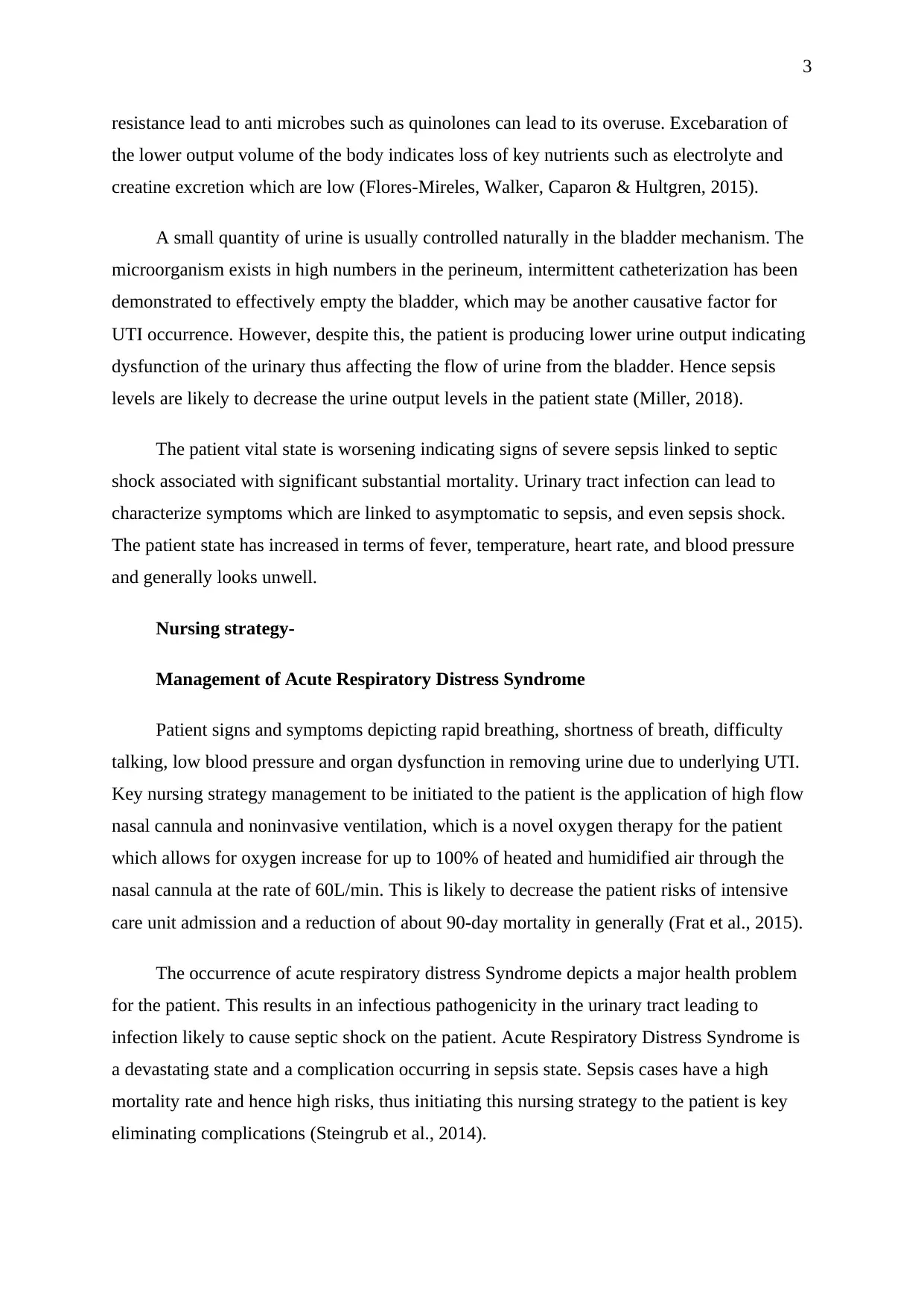
3
resistance lead to anti microbes such as quinolones can lead to its overuse. Excebaration of
the lower output volume of the body indicates loss of key nutrients such as electrolyte and
creatine excretion which are low (Flores-Mireles, Walker, Caparon & Hultgren, 2015).
A small quantity of urine is usually controlled naturally in the bladder mechanism. The
microorganism exists in high numbers in the perineum, intermittent catheterization has been
demonstrated to effectively empty the bladder, which may be another causative factor for
UTI occurrence. However, despite this, the patient is producing lower urine output indicating
dysfunction of the urinary thus affecting the flow of urine from the bladder. Hence sepsis
levels are likely to decrease the urine output levels in the patient state (Miller, 2018).
The patient vital state is worsening indicating signs of severe sepsis linked to septic
shock associated with significant substantial mortality. Urinary tract infection can lead to
characterize symptoms which are linked to asymptomatic to sepsis, and even sepsis shock.
The patient state has increased in terms of fever, temperature, heart rate, and blood pressure
and generally looks unwell.
Nursing strategy-
Management of Acute Respiratory Distress Syndrome
Patient signs and symptoms depicting rapid breathing, shortness of breath, difficulty
talking, low blood pressure and organ dysfunction in removing urine due to underlying UTI.
Key nursing strategy management to be initiated to the patient is the application of high flow
nasal cannula and noninvasive ventilation, which is a novel oxygen therapy for the patient
which allows for oxygen increase for up to 100% of heated and humidified air through the
nasal cannula at the rate of 60L/min. This is likely to decrease the patient risks of intensive
care unit admission and a reduction of about 90-day mortality in generally (Frat et al., 2015).
The occurrence of acute respiratory distress Syndrome depicts a major health problem
for the patient. This results in an infectious pathogenicity in the urinary tract leading to
infection likely to cause septic shock on the patient. Acute Respiratory Distress Syndrome is
a devastating state and a complication occurring in sepsis state. Sepsis cases have a high
mortality rate and hence high risks, thus initiating this nursing strategy to the patient is key
eliminating complications (Steingrub et al., 2014).
resistance lead to anti microbes such as quinolones can lead to its overuse. Excebaration of
the lower output volume of the body indicates loss of key nutrients such as electrolyte and
creatine excretion which are low (Flores-Mireles, Walker, Caparon & Hultgren, 2015).
A small quantity of urine is usually controlled naturally in the bladder mechanism. The
microorganism exists in high numbers in the perineum, intermittent catheterization has been
demonstrated to effectively empty the bladder, which may be another causative factor for
UTI occurrence. However, despite this, the patient is producing lower urine output indicating
dysfunction of the urinary thus affecting the flow of urine from the bladder. Hence sepsis
levels are likely to decrease the urine output levels in the patient state (Miller, 2018).
The patient vital state is worsening indicating signs of severe sepsis linked to septic
shock associated with significant substantial mortality. Urinary tract infection can lead to
characterize symptoms which are linked to asymptomatic to sepsis, and even sepsis shock.
The patient state has increased in terms of fever, temperature, heart rate, and blood pressure
and generally looks unwell.
Nursing strategy-
Management of Acute Respiratory Distress Syndrome
Patient signs and symptoms depicting rapid breathing, shortness of breath, difficulty
talking, low blood pressure and organ dysfunction in removing urine due to underlying UTI.
Key nursing strategy management to be initiated to the patient is the application of high flow
nasal cannula and noninvasive ventilation, which is a novel oxygen therapy for the patient
which allows for oxygen increase for up to 100% of heated and humidified air through the
nasal cannula at the rate of 60L/min. This is likely to decrease the patient risks of intensive
care unit admission and a reduction of about 90-day mortality in generally (Frat et al., 2015).
The occurrence of acute respiratory distress Syndrome depicts a major health problem
for the patient. This results in an infectious pathogenicity in the urinary tract leading to
infection likely to cause septic shock on the patient. Acute Respiratory Distress Syndrome is
a devastating state and a complication occurring in sepsis state. Sepsis cases have a high
mortality rate and hence high risks, thus initiating this nursing strategy to the patient is key
eliminating complications (Steingrub et al., 2014).
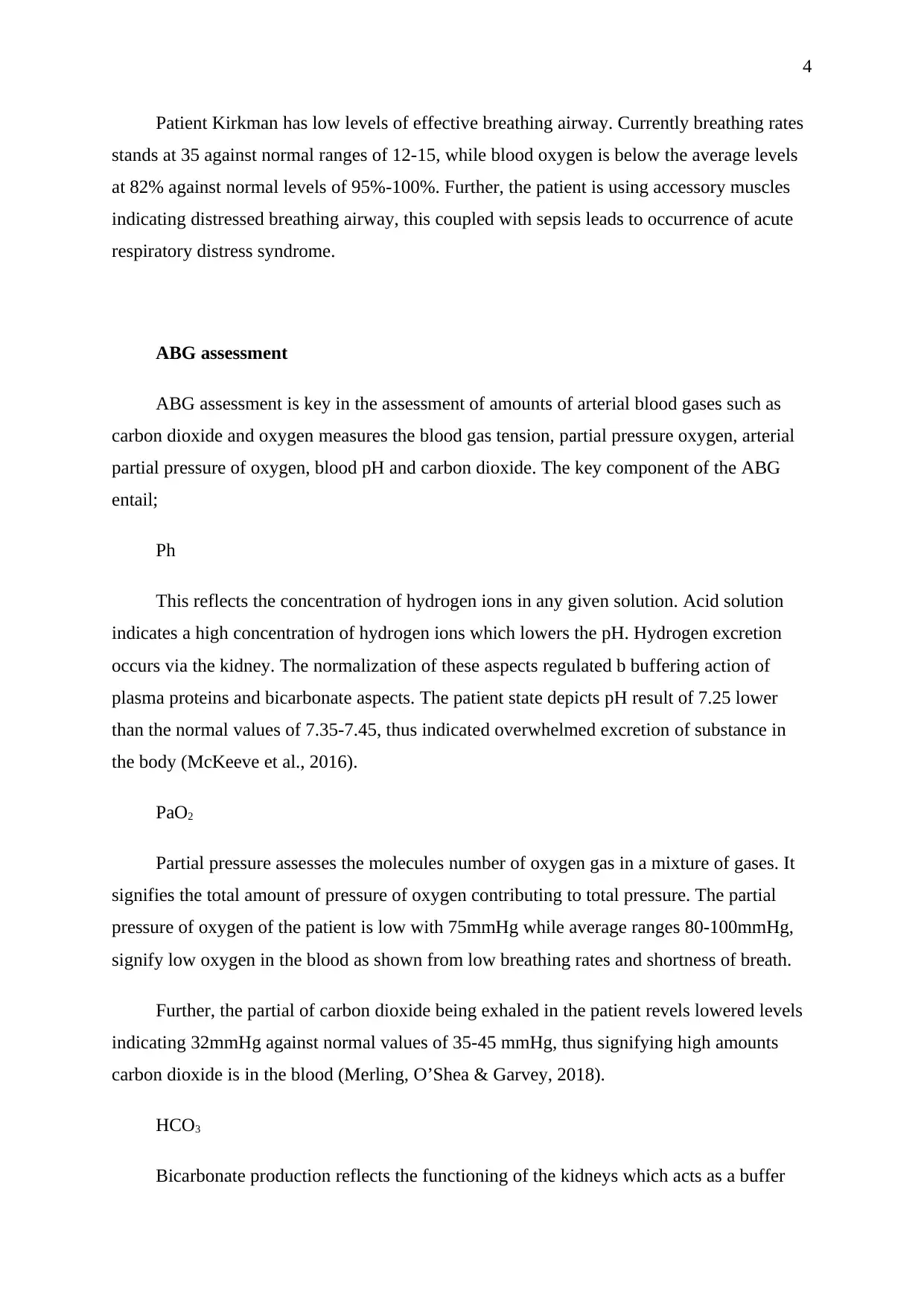
4
Patient Kirkman has low levels of effective breathing airway. Currently breathing rates
stands at 35 against normal ranges of 12-15, while blood oxygen is below the average levels
at 82% against normal levels of 95%-100%. Further, the patient is using accessory muscles
indicating distressed breathing airway, this coupled with sepsis leads to occurrence of acute
respiratory distress syndrome.
ABG assessment
ABG assessment is key in the assessment of amounts of arterial blood gases such as
carbon dioxide and oxygen measures the blood gas tension, partial pressure oxygen, arterial
partial pressure of oxygen, blood pH and carbon dioxide. The key component of the ABG
entail;
Ph
This reflects the concentration of hydrogen ions in any given solution. Acid solution
indicates a high concentration of hydrogen ions which lowers the pH. Hydrogen excretion
occurs via the kidney. The normalization of these aspects regulated b buffering action of
plasma proteins and bicarbonate aspects. The patient state depicts pH result of 7.25 lower
than the normal values of 7.35-7.45, thus indicated overwhelmed excretion of substance in
the body (McKeeve et al., 2016).
PaO2
Partial pressure assesses the molecules number of oxygen gas in a mixture of gases. It
signifies the total amount of pressure of oxygen contributing to total pressure. The partial
pressure of oxygen of the patient is low with 75mmHg while average ranges 80-100mmHg,
signify low oxygen in the blood as shown from low breathing rates and shortness of breath.
Further, the partial of carbon dioxide being exhaled in the patient revels lowered levels
indicating 32mmHg against normal values of 35-45 mmHg, thus signifying high amounts
carbon dioxide is in the blood (Merling, O’Shea & Garvey, 2018).
HCO3
Bicarbonate production reflects the functioning of the kidneys which acts as a buffer
Patient Kirkman has low levels of effective breathing airway. Currently breathing rates
stands at 35 against normal ranges of 12-15, while blood oxygen is below the average levels
at 82% against normal levels of 95%-100%. Further, the patient is using accessory muscles
indicating distressed breathing airway, this coupled with sepsis leads to occurrence of acute
respiratory distress syndrome.
ABG assessment
ABG assessment is key in the assessment of amounts of arterial blood gases such as
carbon dioxide and oxygen measures the blood gas tension, partial pressure oxygen, arterial
partial pressure of oxygen, blood pH and carbon dioxide. The key component of the ABG
entail;
Ph
This reflects the concentration of hydrogen ions in any given solution. Acid solution
indicates a high concentration of hydrogen ions which lowers the pH. Hydrogen excretion
occurs via the kidney. The normalization of these aspects regulated b buffering action of
plasma proteins and bicarbonate aspects. The patient state depicts pH result of 7.25 lower
than the normal values of 7.35-7.45, thus indicated overwhelmed excretion of substance in
the body (McKeeve et al., 2016).
PaO2
Partial pressure assesses the molecules number of oxygen gas in a mixture of gases. It
signifies the total amount of pressure of oxygen contributing to total pressure. The partial
pressure of oxygen of the patient is low with 75mmHg while average ranges 80-100mmHg,
signify low oxygen in the blood as shown from low breathing rates and shortness of breath.
Further, the partial of carbon dioxide being exhaled in the patient revels lowered levels
indicating 32mmHg against normal values of 35-45 mmHg, thus signifying high amounts
carbon dioxide is in the blood (Merling, O’Shea & Garvey, 2018).
HCO3
Bicarbonate production reflects the functioning of the kidneys which acts as a buffer
Secure Best Marks with AI Grader
Need help grading? Try our AI Grader for instant feedback on your assignments.
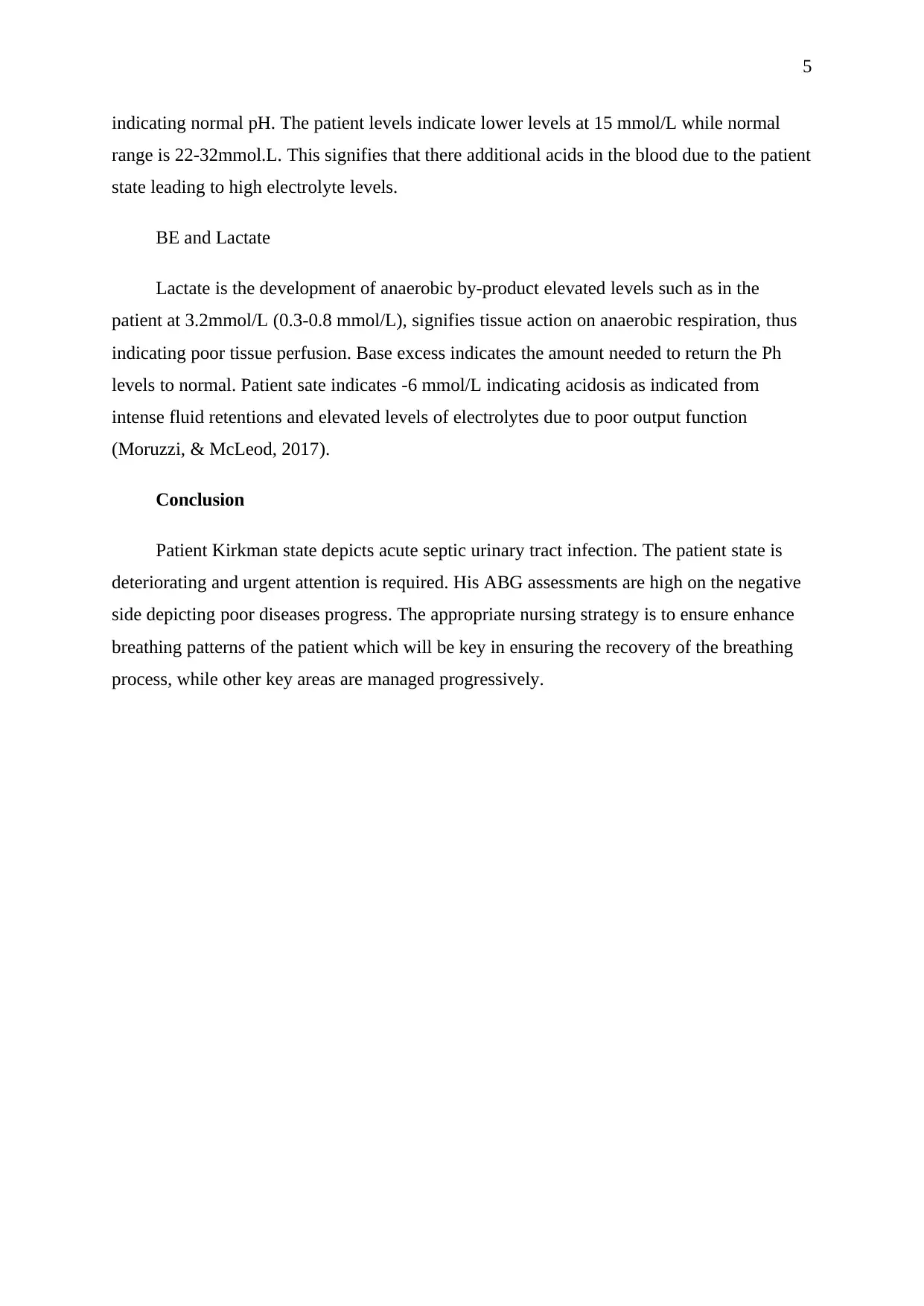
5
indicating normal pH. The patient levels indicate lower levels at 15 mmol/L while normal
range is 22-32mmol.L. This signifies that there additional acids in the blood due to the patient
state leading to high electrolyte levels.
BE and Lactate
Lactate is the development of anaerobic by-product elevated levels such as in the
patient at 3.2mmol/L (0.3-0.8 mmol/L), signifies tissue action on anaerobic respiration, thus
indicating poor tissue perfusion. Base excess indicates the amount needed to return the Ph
levels to normal. Patient sate indicates -6 mmol/L indicating acidosis as indicated from
intense fluid retentions and elevated levels of electrolytes due to poor output function
(Moruzzi, & McLeod, 2017).
Conclusion
Patient Kirkman state depicts acute septic urinary tract infection. The patient state is
deteriorating and urgent attention is required. His ABG assessments are high on the negative
side depicting poor diseases progress. The appropriate nursing strategy is to ensure enhance
breathing patterns of the patient which will be key in ensuring the recovery of the breathing
process, while other key areas are managed progressively.
indicating normal pH. The patient levels indicate lower levels at 15 mmol/L while normal
range is 22-32mmol.L. This signifies that there additional acids in the blood due to the patient
state leading to high electrolyte levels.
BE and Lactate
Lactate is the development of anaerobic by-product elevated levels such as in the
patient at 3.2mmol/L (0.3-0.8 mmol/L), signifies tissue action on anaerobic respiration, thus
indicating poor tissue perfusion. Base excess indicates the amount needed to return the Ph
levels to normal. Patient sate indicates -6 mmol/L indicating acidosis as indicated from
intense fluid retentions and elevated levels of electrolytes due to poor output function
(Moruzzi, & McLeod, 2017).
Conclusion
Patient Kirkman state depicts acute septic urinary tract infection. The patient state is
deteriorating and urgent attention is required. His ABG assessments are high on the negative
side depicting poor diseases progress. The appropriate nursing strategy is to ensure enhance
breathing patterns of the patient which will be key in ensuring the recovery of the breathing
process, while other key areas are managed progressively.
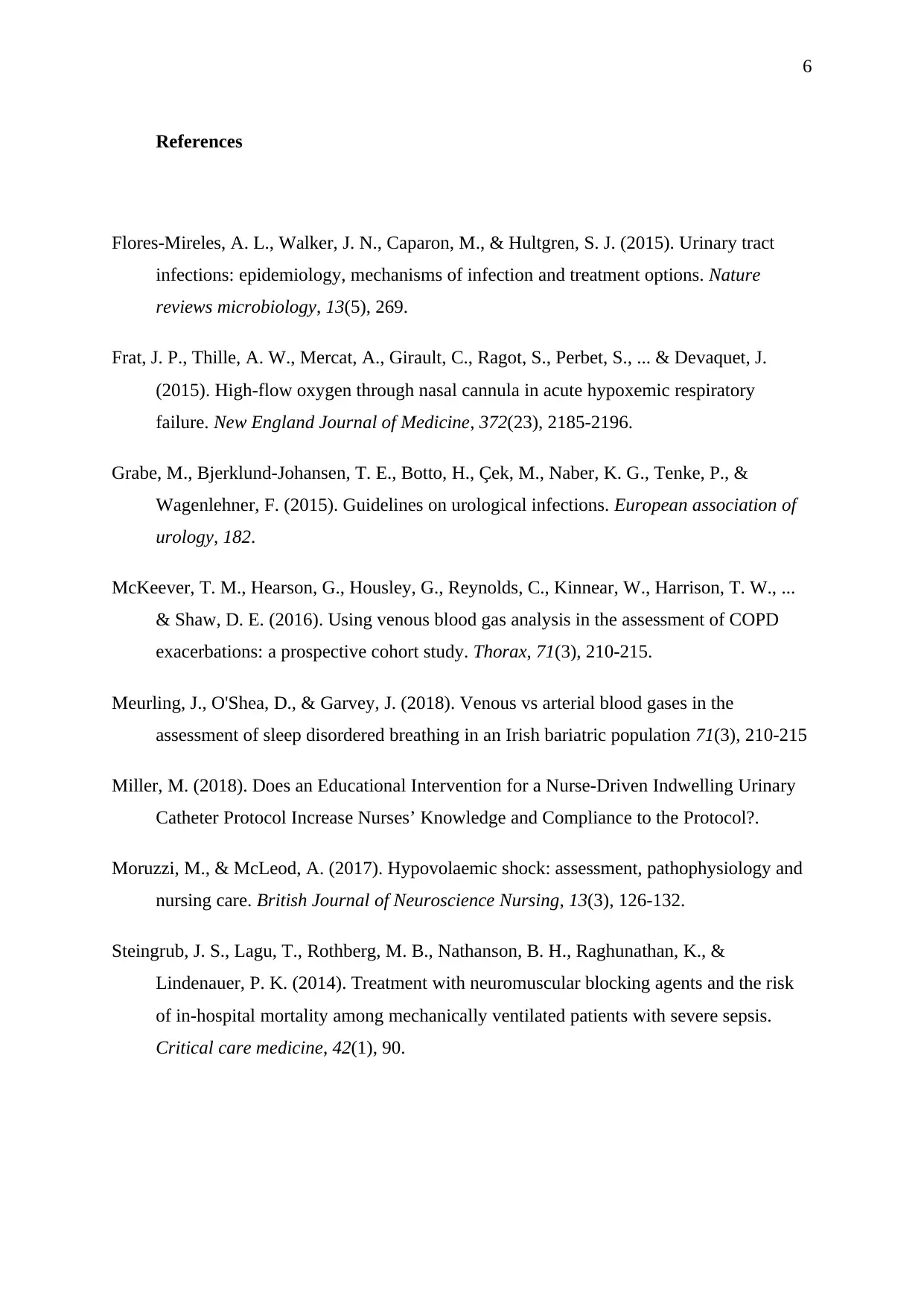
6
References
Flores-Mireles, A. L., Walker, J. N., Caparon, M., & Hultgren, S. J. (2015). Urinary tract
infections: epidemiology, mechanisms of infection and treatment options. Nature
reviews microbiology, 13(5), 269.
Frat, J. P., Thille, A. W., Mercat, A., Girault, C., Ragot, S., Perbet, S., ... & Devaquet, J.
(2015). High-flow oxygen through nasal cannula in acute hypoxemic respiratory
failure. New England Journal of Medicine, 372(23), 2185-2196.
Grabe, M., Bjerklund-Johansen, T. E., Botto, H., Çek, M., Naber, K. G., Tenke, P., &
Wagenlehner, F. (2015). Guidelines on urological infections. European association of
urology, 182.
McKeever, T. M., Hearson, G., Housley, G., Reynolds, C., Kinnear, W., Harrison, T. W., ...
& Shaw, D. E. (2016). Using venous blood gas analysis in the assessment of COPD
exacerbations: a prospective cohort study. Thorax, 71(3), 210-215.
Meurling, J., O'Shea, D., & Garvey, J. (2018). Venous vs arterial blood gases in the
assessment of sleep disordered breathing in an Irish bariatric population 71(3), 210-215
Miller, M. (2018). Does an Educational Intervention for a Nurse-Driven Indwelling Urinary
Catheter Protocol Increase Nurses’ Knowledge and Compliance to the Protocol?.
Moruzzi, M., & McLeod, A. (2017). Hypovolaemic shock: assessment, pathophysiology and
nursing care. British Journal of Neuroscience Nursing, 13(3), 126-132.
Steingrub, J. S., Lagu, T., Rothberg, M. B., Nathanson, B. H., Raghunathan, K., &
Lindenauer, P. K. (2014). Treatment with neuromuscular blocking agents and the risk
of in-hospital mortality among mechanically ventilated patients with severe sepsis.
Critical care medicine, 42(1), 90.
References
Flores-Mireles, A. L., Walker, J. N., Caparon, M., & Hultgren, S. J. (2015). Urinary tract
infections: epidemiology, mechanisms of infection and treatment options. Nature
reviews microbiology, 13(5), 269.
Frat, J. P., Thille, A. W., Mercat, A., Girault, C., Ragot, S., Perbet, S., ... & Devaquet, J.
(2015). High-flow oxygen through nasal cannula in acute hypoxemic respiratory
failure. New England Journal of Medicine, 372(23), 2185-2196.
Grabe, M., Bjerklund-Johansen, T. E., Botto, H., Çek, M., Naber, K. G., Tenke, P., &
Wagenlehner, F. (2015). Guidelines on urological infections. European association of
urology, 182.
McKeever, T. M., Hearson, G., Housley, G., Reynolds, C., Kinnear, W., Harrison, T. W., ...
& Shaw, D. E. (2016). Using venous blood gas analysis in the assessment of COPD
exacerbations: a prospective cohort study. Thorax, 71(3), 210-215.
Meurling, J., O'Shea, D., & Garvey, J. (2018). Venous vs arterial blood gases in the
assessment of sleep disordered breathing in an Irish bariatric population 71(3), 210-215
Miller, M. (2018). Does an Educational Intervention for a Nurse-Driven Indwelling Urinary
Catheter Protocol Increase Nurses’ Knowledge and Compliance to the Protocol?.
Moruzzi, M., & McLeod, A. (2017). Hypovolaemic shock: assessment, pathophysiology and
nursing care. British Journal of Neuroscience Nursing, 13(3), 126-132.
Steingrub, J. S., Lagu, T., Rothberg, M. B., Nathanson, B. H., Raghunathan, K., &
Lindenauer, P. K. (2014). Treatment with neuromuscular blocking agents and the risk
of in-hospital mortality among mechanically ventilated patients with severe sepsis.
Critical care medicine, 42(1), 90.
1 out of 6
Related Documents
Your All-in-One AI-Powered Toolkit for Academic Success.
+13062052269
info@desklib.com
Available 24*7 on WhatsApp / Email
![[object Object]](/_next/static/media/star-bottom.7253800d.svg)
Unlock your academic potential
© 2024 | Zucol Services PVT LTD | All rights reserved.





